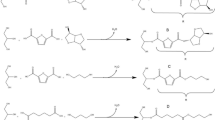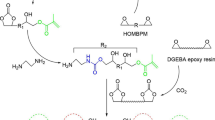Abstract
This paper deals with a study on toughening of an unsaturated polyester resin (UPR) using maleimide end-capped oligomers of polypropylene glycol (M-PPG), polytetramethyene oxide (M-PTMO), and polyethylene glycol (M-PEG) of varying molecular weights. These macro bismaleimides with large spacing between the functional groups were synthesized from the corresponding polyols (hydroxy telechelics) by reaction with (4-Maleimido) benzoyl chloride (MBC). These derivatives were characterised by chemical and spectral methods. These were then blended and co-cured with a UP resin based on copoly-propylene glycol (terephthalate –maleate) and relying on maleic acid–styrene copolymerisation for curing. The impacts of the nature, concentration and molecular weight of the telechelic additive on the physical and mechanical properties of the resultant unsaturated polyester resin (UPR) blends have been examined. Addition of the telechelics improved the mechanical characteristics of the crosslinked systems significantly. The improvement in fracture properties for a telecheilc was directly correlatable to a decrease in overall crosslink density estimated exprimentally as well as theoretically. The additive’s backbone structure dictated the Tg and related properties of the blend. The properties were found to be the best for the blend toughened with M-PPG with a molecular weight 2000 g/mol, at 2.5 parts per hundred parts.The morphological features at this concentration as reflected in scanning electron microscopic analyses showed descrete poly ether particles microphase separation in the UPR matrix that acted as a crack path arrester.

Graphical Abstract














Similar content being viewed by others
Data availability
The raw/processed data required to reproduce these findings cannot be shared at this time as the data also form part of an ongoing study.
References
Johnson KG, Yang LS (2008) In modern polyesters: chemistry and Technology of Polymers and Copolyesters. Wiley, New York, pp 9–21
Lu M, Shim M, Kim S (2001) Reaction mechanism of an unsaturated polyester system containing thickeners. Eur Polym J 37(5):1075–1078
Malik M, Choudhary V, Varma IK (2000) Current status of unsaturated polyester resins. J Macromolec Sci, Part C 40(2–3):139–165
Mansour SH, Asaad JN, Abd-El-Messieh SL (2006) Synthesis and characterization of brominated polyester composites. J Appl Polym Sci 102(2):1356–1365
Asaad JN, Abd-El-Messieh SL (2008) Effect of glycol and filler types on some polymeric composite properties. J Appl Polym Sci 109(3):1916–1924
Tawfik SY, Asaad JN, Sabaa MW (2003) Effect of polyester backbone structure on the cured products properties. Polym Test 22(7):747–759
Hochschule H (2003) Composites ASM handbook/extraction polyester resins, Werkstoff technologien/Kunststoff technik Oct.
Domun N, Hadavinia H, Zhang T, Sainsbury T, Liaghata GH, Vahida S (2015) Improving the fracture toughness and the strength of epoxy using nanomaterials – a review of the current status. Nanoscale 7:10294–10329
Singh RP, Zhang M, Chan D (2002) Toughening of a brittle thermosetting polymer: effects of reinforcement particle size and volume fraction. J Mater Sci 37:781–788
Cherian AB, Abraham BT, Thachil ET (2006) Modification of unsaturated polyester resin by polyurethane prepolymers. J Appl Polym Sci 100(1):449–456
Guo Q, Zheng H (1999) Miscibility and crystallization of thermosetting polymer blends of unsaturated polyester resin and poly (ϵ-caprolactone). Polymer 40(3):637–646
Martuscelli E, Musto P, Ragosta G (Eds.) (1996). Advanced routes for polymer toughening (Vol. 10). Elsevier
Folkes MJ, Hope PS (eds) (1993) Polymer blends and alloys. Blackie Academic & Professional, London
Atta AM, Elnagdy SI, Abdel-Raouf ME (2005) Compressive properties and curing behaviour of unsaturated polyester resins in the presence of vinyl Ester resins derived from recycled poly (ethylene terephthalate). J Polym Res 12:373–383
Roberts KN (2002) An investigation of core–shell rubber modified vinyl ester resins. PhD Thesis, Monash University, Clayton, Victoria, Australia
Chou YC, Lee LJ (1994) Reaction-induced phase separation during the formation of a polyurethane-unsaturated polyester interpenetrating polymer network. Polym Eng Sci 34(16):1239–1249
Shaker ZG, Browne RM, Stretz HA, Cassidy PE, Blanda MT (2002) Epoxy-toughened, unsaturated polyester interpenetrating networks. J Appl Polym Sci 84(12):2283–2286
Asaad JN (2013) Synthesis and characterization of unsaturated polyester/carborundum composites. J Appl Polym Sci 129(4):1812–1819
Beg MDH, MoshiulAlam AKM, Yunus RM, Mina MF (2015) Improvement of interaction between pre-dispersed multi-walled carbon nanotubes and unsaturated polyester resin. J Nanopart Res 17(53)
Cao Y (2018) Applications of cellulose nanomaterials in pharmaceutical science and pharmacology. Express Polym Lett 12(9):768–780
He S, Petkovich ND, Liu K, Qian Y, Macosko CW, Stein A (2017) Unsaturated polyester resin toughening with very low loadings of GO derivatives. Polymer 110:149–157
Rusmirović JD, Radoman T, Džunuzović ES, Džunuzovi JV, Markovski J, Spasojević P, Marinković AD (2017) Effect of the modified silica nanofiller on the mechanical properties of unsaturated polyester resins based on recycled polyethylene terephthalate. Polym Compos 38(3):538–554
Rahman MT, Hoque MA, Rahman GT, Gafur MA, Khan RA, Hossain MK (2019) Study on the mechanical, electrical and optical properties of metal-oxide nanoparticles dispersed unsaturated polyester resin nanocomposites. Results Physics 13:102264
Maspoch MLL, Martinez AB (1998) Toughening of unsaturated polyester with rubber particles. Part I: morphological study. Polym Eng Sci 38(2):282–289
Maspoch MLL, Martinez AB (1998) Toughening of unsaturated polyester with rubber particles. Part II: fracture behavior. Polym Eng Sci 38(2):290–298
Park JG, Pohang CE (1990) Chan Eon lnst Sci Tech 1.4(3):266
Abbate M, Martuscelli E, Musto P, Ragosta G, Scarinzi G (1995) Maleated polyisobutylene: a novel toughener for unsaturated polyester resins. J Appl Polym Sci 58(10):1825–1837
Huang YJ, Wu JH, Liang JG, Hsu MW, Ma JK (2008) Toughening of unsaturated polyester resins with core–shell rubbers. J Appl Polym Sci 107(2):939–950
Ahmadi M, Moghbeli MR, Shokrieh MM (2012) Rubber modification of unsaturated polyester resin with Core–Shell rubber particles: effect of Shell composition, Polymer Engineering and Science 52(9):1928–1937
Ragosta G, Bombace M, Martuscelli E, Musto P, Russo P, Scarinzi G (1999) A novel compatibilizer for the toughening of unsaturated polyester resins. J Mater Sci 34(5):1037–1044
Guhanathan S, Hariharan R, Sarojadevi M (2004) Studies on castor oil–based polyurethane/polyacrylonitrile interpenetrating polymer network for toughening of unsaturated polyester resin. J Appl Polym Sci 92(2):817–829
Nair CR, Manshad PK, Ashir AM, Athul S (2020) Synthesis of 3-carbonyl acrylic acid-functionalized polystyrene and an insight in to its role in cross linking and grafting of polystyrene on to natural rubber. Eur Polymer J 109688
Kokubo T, Iwatsuki S, Tamashita Y (1968) Studies on the charge-transfer complex and polymerization, XVII The reactivity of the charge-transfer complex in alternating radical copolymerization of vinyl ethers and maleic anhydride. Macromolecules 1(6):482–488
Nemtoi G, Beldie C, Tircolea C, Popa I, Cretescu I, Humelnicu I, Humelnicu D (2001) Behaviour of the poly (maleic anhydride-co-vinyl acetate) copolymer in aqueous solutions. Eur Polym J 37(4):729–735
Barrales-Rienda J M, De La Campa J G, Ramos J G (1977) Free-radical copolymerizations of n-phenyl maleimide. J Macromolec Sci—Chem 11(2): 267–286
Nair CR (1993) Copolymerization of 4-maleimidobenzoic acid with alkyl acrylates. Kinetic penultimate unit effect and copolymer characteristics. Macromolecules 26(1):47–54
Cherian AB, Varghese LA, Thachil ET (2007) Epoxy-modified, unsaturated polyester hybrid networks. Eur Polym J 43(4):1460–1469
Cherian AB, Thachil ET (2003) Blends of unsaturated polyester resin with functional elastomers. J Elastomers Plastics 35(4):367–380
Remya Suresh (2018) Studies on the mechanical and dielectric properties of unsaturated polyester resin modified by MWCNT, graphene oxide and rubber seed oil, PhD Thesis, Cochin University of science and Technology
Wetton RE, Fielding-Russell GS, Fulcher KU (1970) Molecular relaxations in chain polyethers: a dielectric study. In Journal of Polymer Science Part C: Polymer Symposia (Vol. 30, No. 1, pp. 219-231). New York: Wiley Subscription Services, Inc., A Wiley Company
Scherzer T (2004) Photopolymerization of acrylates without photo initiators with short-wavelength UV radiation: a study with real-time Fourier transform infrared spectroscopy. J Polym Sci A Polym Chem 42(4):894–901
Lee TY, Kaung W, Jönsson ES, Lowery K, Guymon CA, Hoyle CE (2004) Synthesis and photopolymerization of novel multifunctional vinyl esters. J Polym Sci A Polym Chem 42(17):4424–4436
Coleman Jr L E, Conrady J A (1959) Nitrogen-containing monomers, I. Copolymerization reactions of N-alkyl maleamic acids and N-alkyl maleimides. J Polym Sci 38(133): 241–245
Gacal B, Cianga L, Agag T, Takeichi T, Yagci Y (2007) Synthesis and characterization of maleimide (co) polymers with pendant benzoxazine groups by photoinduced radical polymerization and their thermal curing. J Polym Sci A Polym Chem 45(13):2774–2786
Abayasekara D R (1984) Effects of N-substituents on the polymerization properties of maleimide, PhD Thesis, Virginia Commonwealth University
Francis B, Thomas S, Asari GV, Ramaswamy R, Jose S, Rao VL (2006) Synthesis of hydroxyl-terminated poly (ether ether ketone) with pendent tert-butyl groups and its use as a toughener for epoxy resins. J Polym Sci B Polym Phys 44(3):541–556
Goudarzian N, Hashemi S A, Mirjalili M. (2016). Unsaturated polyester resins modified with cresol novolac epoxy and silica nanoparticles: processing and mechanical properties. Int J Chem Petrol Sci, 5(1): 13–26
Liu C, Shang Q, Jia P, Dai Y, Zhou Y, Liu Z (2016) Tung oil-based unsaturated co-ester macromonomer for thermosetting polymers: synergetic synthesis and copolymerization with styrene. ACS Sustain Chem Eng 4(6):3437–3449
Author information
Authors and Affiliations
Corresponding author
Ethics declarations
Conflict of interest
There are no conflicts to declare.
Additional information
Publisher’s note
Springer Nature remains neutral with regard to jurisdictional claims in published maps and institutional affiliations.
Highlights
• Maleimide End- Capped Polyether Telechelics were successfully synthesised.
• A tough and strong resin resulted on blending and curing these telechelics with an unsaturated polyester resin.
Electronic supplementary material
ESM 1
(PDF 1079 kb)
Rights and permissions
About this article
Cite this article
Jeemol, P.A., Mathew, S. & Nair, C.P.R. Maleimide end- capped polyether telechelics as novel toughening agents for unsaturated polyester resin. J Polym Res 27, 300 (2020). https://doi.org/10.1007/s10965-020-02197-z
Received:
Accepted:
Published:
DOI: https://doi.org/10.1007/s10965-020-02197-z




